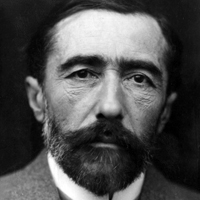Heart of Darkness by Joseph Conrad: Introduction
The novella Heart of Darkness was first written in 1899 in a serial form in Blackwood's magazine, later it was published in 1902 and finally in book form it was published in 1942 in Youth: A Narrative, and Two Other Stories by a great modern novelist, Joseph Conrad.

Joseph Conrad (1857-1924)
In 1890 Conrad sailed to the Belgian Congo and he gave his experiences a shape of novella (Heart of Darkness) after a long gap of time. On the surface level, it is like a mystery story, but on an implicit level, it is a journey within, a journey into the subconscious.
It is his one of the best stories which explores the terrifying depths of human corruptibility, social and psychological disorder through the metaphor of a journey to the heart of the African continent. Heart of Darkness in particular, offers a connection between Victorian norms and values and the principles of modernism. Like their Victorian novelists, this novel relies on tradition as a heroism, which is yet under continuous attack in a changing world. Like much of the best modernist literature produced in the early decades of the twentieth century, Heart of Darkness is much about alienation, confusion, and profound doubt as it is about imperialism.
Imperialism is at the center of Heart of Darkness. By the 1890s, most of the world’s dark and unreachable places had been positioned under European control, and the major European powers were stretched thin, trying to administer and protect massive empires. Cracks were beginning to appear in the system: riots, wars, and the wholesale abandonment of commercial enterprises all threatened the white men living in the distant corners of empires. Things were clearly falling apart. Heart of Darkness suggests that this is the natural result when men are allowed to operate outside a social system of checks and balances: power, especially power over other human beings, inevitably corrupts. Heart of Darkness is thus, at its most abstract level, a narrative about the difficulty of understanding the world beyond the self, about the ability of one man to judge another.
The story centers around Marlow and Kurtz, two major characters in the novel. Kurtz symbolically stands for greed and commercial mentality, love for power, the repentant sinner and the influence of barbarism on civilized people. In the same manner, Marlow symbolizes the spirit of adventure and a love of knowledge. Heart of Darkness is considered an excellent work for using narrative within the narrative. One narrative is by an unnamed person in the ship and another narrator is Marlow himself. Both Marlow and Kurtz both travel to the interiors of Africa for the collection of ivory, but both return at last being experienced from a different level. Kurtz sees the horror and destruction in the interior whereas Marlow sees the darkest side of the human mind.
Literary Spotlight
Exploration of Evil in Heart of Darkness
Kurtz's fall in Heart of Darkness
Relation between Colonizer and Colonized
Symbolism of Light and Darkness in Heart of Darkness
Heart of Darkness is Essentially a Journey Within
Use of Narrative Technique in Heart of Darkness
Use of Irony in Heart of Darkness
Significance of the Title Heart of Darkness
 |
bachelorandmaster.com |